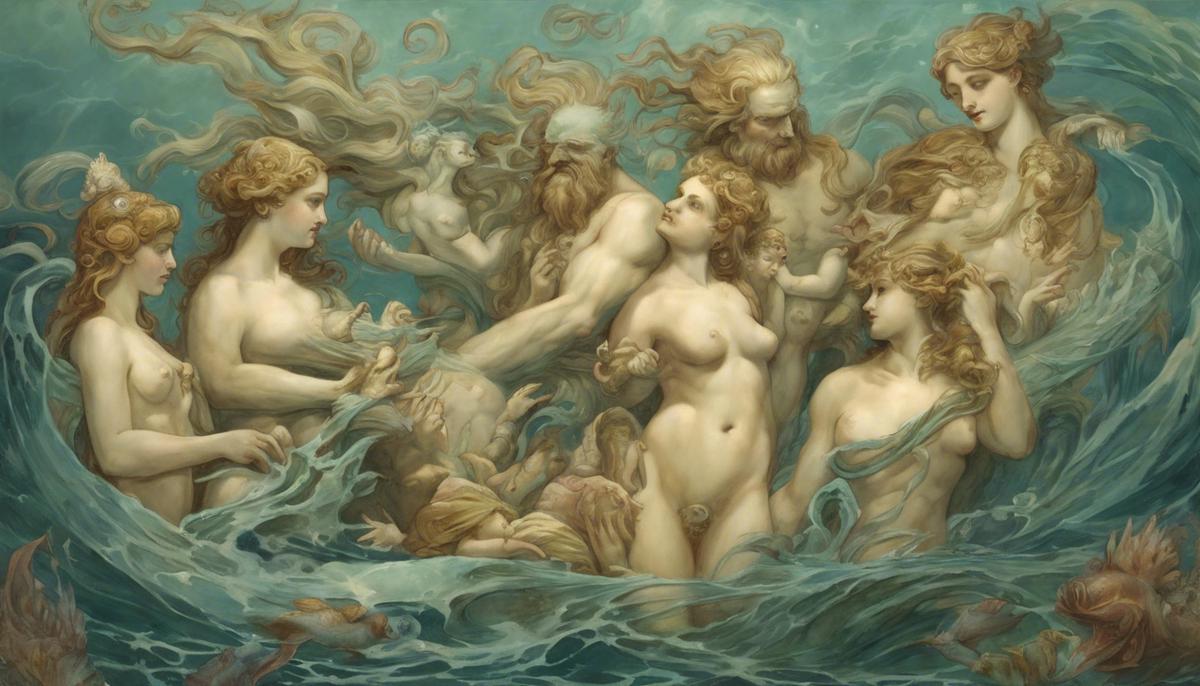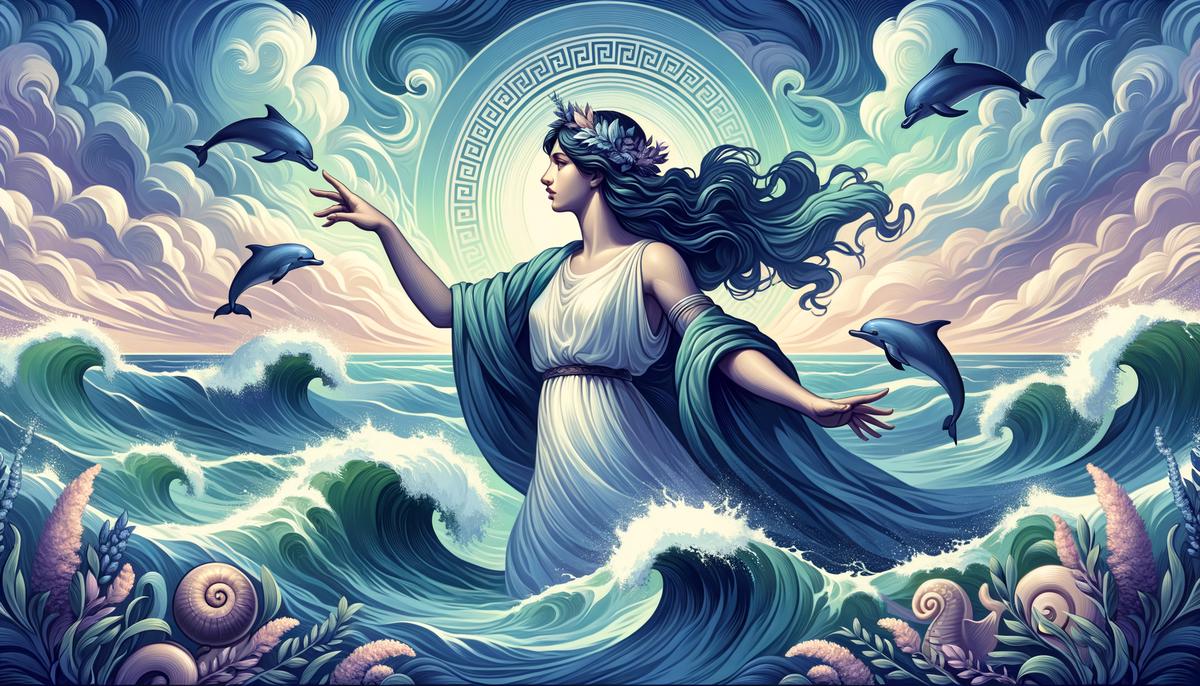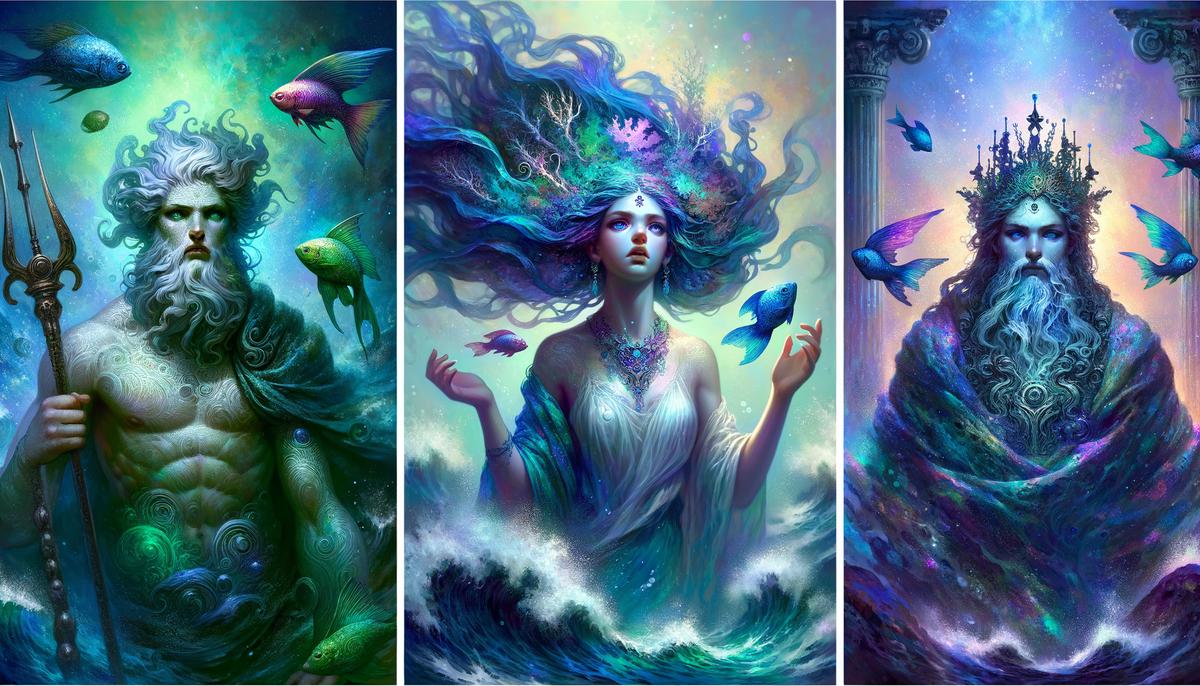Amphitrite, a figure woven into the tapestry of Greek mythology, represents the intricate relationship between ancient human cultures and the mysterious marine world. As we navigate through her stories and symbols, we uncover how her essence has been shaped, revered, and depicted across various epochs, reflecting humanity's fascination with the ocean's majesty and mystery.
Amphitrite's Origins
Amphitrite emerges from a lineage steeped in the essence of the sea. Her parents, Nereus and Doris, were deities of the ocean. She stood among fifty, sometimes cited as a hundred, sisters known as the Nereids. Each represented different facets of the ocean, from the soothing lull of waves to the roars of sea storms.
Born in this realm of briny depths and whispering waves, Amphitrite inherited a connection with all marine life, setting the stage for her future sovereignty over the seas. Historical texts and arts pay homage to her through symbols like dolphins and seahorses, emblematic of her reign and her affinity with the creatures she governs.
Amphitrite's narrative intertwines with broader mythological themes that portray female divinities as elemental forces. Her upbringing amid a myriad of sisters, each echoing the ocean's call, highlights the interconnection between nature and female divinity in Greek mythology. This notion reinforces Amphitrite's role as a nurturer and guardian of the ocean's vast territories.
Her descent from Nereus, "Old Man of the Sea," sheds light on her command over the sea and its denizens. This lineage bestowed upon her an intrinsic understanding of marine realms and a paradoxical loneliness. Despite being surrounded by sister Nereids, her specific tales often portray a goddess whose unique destiny leads her to a solitary yet significant chapter alongside Poseidon.
Amphitrite's origins reveal that her role extends beyond mythology; she signifies the ancient human endeavor to personify and understand the natural world. Her story echoes ancient reverence for the sea's omnipotent presence—a presence both benevolent and formidable, much like Amphitrite herself. These narratives paint a broader stroke on human interaction with nature, placing Amphitrite at the confluence of awe, reverence, and the perennial quest to fathom the unfathomable depths.

Amphitrite and Poseidon
The story of Amphitrite and Poseidon starts less like a fairy tale and more like an ancient mythological caper. Poseidon, the embodiment of oceanic force, set his heart on Amphitrite the moment he saw her dancing with her Nereide sisters on Naxos. Smitten, he promptly proposed to her.
Amphitrite, however, was not an easy catch. Perhaps embodying the elusive nature of the sea, she initially fled, seeking solitude at the farthest bounds of the ocean near Atlas. The reasons behind her flight have brewed much speculation, adding an alluring mystique to her character and placing her autonomy at the forefront.
Poseidon, not one to give up, dispatched a charming dolphin to find and persuade Amphitrite. Successfully swayed by Dolphin's persuasive skills, Amphitrite agreed to marry Poseidon, symbolizing the reconciliation of stormy power with tranquil grace.
Their union, celebrated in art and story, underscored a balance between temerity and calm. As myths would have it, their marriage stabilized the sea—a reflection of how their differing yet complementary attributes brought order. Poseidon continued to wield his might with the trident, while Amphitrite calmed the resultant waves, tempering his wrath with her serenity.
From this powerful coupling arose Triton, a demigod merman echoing his father's formidable strength and his mother's genteel nature—a merger of their sovereignty over the sea realms. The impact of their union spans the pillars of Greek lore wherein deities embody nature's primal forces and dictate human engagements with the elements.
The tale of Amphitrite and Poseidon invites one to ponder upon the intricate dance of relationships charged with power, independence, persuasion, and balance—an eternal narrative reverberating through the echoes of waves and woven into the fabric of mythology. Ancient tales communicate profound ideas about harmony between seeming opposites, underscoring perennial themes that continue to fascinate and instruct.

Symbolism and Powers
The symbolism of Amphitrite elucidates how deeply her identity is woven into the fabric of marine mythology. The dolphin and the seahorse stand out as her primary symbols, transcending mere animals to become heralds of her marine sovereignty and nurturing disposition.
Dolphins, revered for their intelligence and playful demeanor, reflect Amphitrite's wisdom and benevolence. Ancient seafarers considered sightings of dolphins as auspicious, a sign of safe passage heralded by Amphitrite, illustrating her role as protector of sailors and guardian of the waters. This portrayal as a compassionate deity is vividly illustrated by the legendary dolphin dispatched by Poseidon, painting her as an elusive beauty responsive to genuine outreach.
Seahorses, creatures that captivate with their unusual profiles and graceful bearing, symbolize the transportive nature of the sea, capable of moving seamlessly between the aqueous realms Amphitrite commands. Often depicted pulling her chariot across oceanic expanses, they blend mystery and majesty, funneling back to Amphitrite's image as both a commanding presence and a nurturing entity.
Her powers reinforce this dynamic persona. Amphitrite had the formidable ability to still the waters themselves, calming roiling seas alive with tempest and turmoil. In this capacity, she complemented Poseidon, creating balance where there might otherwise be unchecked chaos. Where Poseidon might summon a storm, Amphitrite could quell it, showcasing that true power often resides not just in creation but in restraint.
Amphitrite's powers extend into contemporary dialogues about the environment, symbolizing not just the allure of the ocean but its need for reverence and protection. Her mythological acts of calming the seas can be mirrored in our efforts to protect marine environments, pointing to ancient narratives that fructify into modern ecological advocacy. Her mythology, laden with symbols of marine affiliation and might, bridges past cultures with contemporary issues, offering a model of stewardship that values both the mighty and the fragile in our natural world.
To delve into Amphitrite's mythos is to uncover layers of symbolism that characterize her as a deity and encapsulate our lasting enthrallment with, and inherent obligation to, the world's oceans. Amphitrite emerges as a figure of ancient worship and a continuous reminder of the deep connections humanity shares with the vast waters of our planet.

Amphitrite in Art and Culture
The diverse portrayals of Amphitrite in art and culture unveil a fascinating dialogue between the mythical past and artistic interpretation across ages. In ancient Greek marble sculptures, Amphitrite is immortalized alongside Poseidon, lavished with exquisite carvings symbolizing her prestige and connection to the seas. Her elegant poise conveys her revered status and mirrors the Greeks' deep respect for the ocean's energies.
In the Roman period, Amphitrite was captured in elaborate mosaics, such as those found in Pompeii. Here she rides majestically with Poseidon in a chariot drawn by hippocamps, testament to the cultural synthetization of Greek and Roman mythologies and continuity in her maritime guardianship. These mosaics served not just as decorative arts but as cultural statements of divine protection and affirmation of life's cyclicality.
Renaissance and baroque periods brought revitalized interest, with artists like Botticelli and Titian portraying sea gods with a zest that mirrored renewed humanistic values. Amphitrite surfaces in artworks flush with allegorical themes, where seas suggest not merely geographical realms but vistas of human emotion and discovery. With lush color palettes and flowing forms, these renditions sway like the undulating sea itself, ferrying Amphitrite's myth into new narrative vocabularies.
Contemporary digital art and unconventional media have embraced Amphitrite, reflecting current concerns and fascinations. She is unfolded in dynamic new motifs, from eco-warrior goddess in graphic novels to symbolic custodian of marine conservation in eco-art installations. These modern portrayals resonate with today's anxieties about oceanic preservation and climate change, recasting her as a sentinel for environmental activism—a significant cultural transmutation from ancient protector to modern guardian.
Amphitrite's enduring inspiration across art forms accentuates her dual essence: a nurturing caregiver and formidable overlord of the deeps. In every brush stroke, chisel mark, or digital hue shift, Amphitrite mirrors both the beauties and the profundities of the seas—a longstanding testimony of artistic fascination with mythology threaded through culturally diverse expressions.
From ancient clay to digital pixels, Amphitrite has been continuously portrayed not just as Poseidon's consort but as a sovereign entity, captivatingly intertwined with mankind's perpetual romance with the majesty and mystery of the sea. This vivid presence across historical periods and cultural spheres underscores that while mediums may evolve, the essence of what she stands for—an awe-inspiring and deeply interconnected universe—remains a steadfast cliff against the ebbing tides of time.

Comparative Mythology
Amphitrite shares the marine stage with other mythic figures like Thalassa and her Roman counterpart Salacia, each adding their unique hue to the palette of sea deities. These aquatic divinities splash across the broad canvas of mythology with intertwining roles and distinctive narratives, offering insight into the cultural undercurrents that shaped their worship.
Thalassa, personified as the literal sea in Greek mythology, represents more of an elemental force compared to the personable character of Amphitrite. While Amphitrite reigns with a distinct persona steeped in narrative and royal marvels alongside Poseidon, Thalassa's presence is more primal—a ubiquitous essence of the sea's sprawl rather than a deity interacting with other Olympians and mortals.
The Roman narrative introduces Salacia, who commands her scene with a flavor remarkably similar to Amphitrite, yet distinctively Roman. As the wife of Neptune, the Roman echo of Poseidon, Salacia shares Amphitrite's matrimonial ties but steps up the drama. Her name, derived from 'sal,' meaning salt, underscores her connection to the deeper layers of the sea. Salacia is often depicted alongside Neptune, reins in hand, actively guiding the realms below the waves. This portrayal emphasizes a side that is more sovereign and less overshadowed by her consort compared to Greek representations of Amphitrite.
While Amphitrite and Salacia both mingle their destinies with their mighty sea god husbands, Salacia occasionally steers closer to sovereignty and independent rule over saline realms. In contrast, Amphitrite feels more like an embodiment of tranquil seas and nurturing protectorate over marine life—an extension of Poseidon's domain rather than a ruler of her own.
Roaming through Greek and Roman mythology, we encounter varied depictions of sea deities that mirror each culture's unique relationship with the oceans. Thalassa flows through Greek lore as an omnipresent


Leave a Reply